The year is 2028. It’s 8 p.m. on a Wednesday night and you’re famished. You’re staring wistfully at the only remaining item in your refrigerator: a package of sausages with an unappetizing grayish hue. Ugh. Did they always look like that? Are they still safe to eat? In 2018, you’d have to rely on your sense of smell and take a gamble. But in 2028, you might simply wave your smartphone over the package. The smartphone interrogates the package’s embedded sensor, which measures the concentration of gases associated with meat decomposition. The smartphone displays the message “Safe to eat within the next 20 hours,” and then offers a list of recipes for cooking with sausages. Too hungry to bother with the recipes, you tear open the package, toss the sausages into a frying pan, and discard the package—along with its sensor technology.
This imagined scene of salvation by smartphone captures just one of many anticipated Internet of Things applications. IoT is possible now because of the convergence of low-cost, low-power components, specifically microprocessors, cellular radios, Wi-Fi radios, and MEMS sensors. There’s also a proven market for aggregated IoT data on consumer behaviors, known as big data. IHS Markit, a research firm that tracks and analyzes the electronics industry, predicts that the global volume of IoT devices will more than quadruple, from 27 billion connected devices in 2017 to 125 billion in 2030.
To say that the semiconductor industry is excited would be a huge understatement. Underlying that excitement is a major assumption—that all of these components will be made using silicon, leveraging existing billion-dollar chip factories known as fabs. But that assumption is wrong. Disposable sensors that sniff out the safety of your future sausage won’t be made on silicon. Instead they’ll be printed directly on the paper or plastic packaging.
The sensors available for IoT applications today are based on MEMS (microelectromechanical systems). Fabricated on silicon wafers using methods developed originally for making semiconductor ICs, MEMS sensors use microscopic mechanical structures to detect motion, sound, pressure, light, or even species of gas. Tiny diaphragms, cantilevers, vibrating masses, or circuitous channels, usually smaller than 100 micrometers (the diameter of a human hair), respond to a physical stimulus and then transduce it to an electronic signal. When coupled to a radio and antenna, MEMS sensors can send their electronic data wirelessly to the Internet.
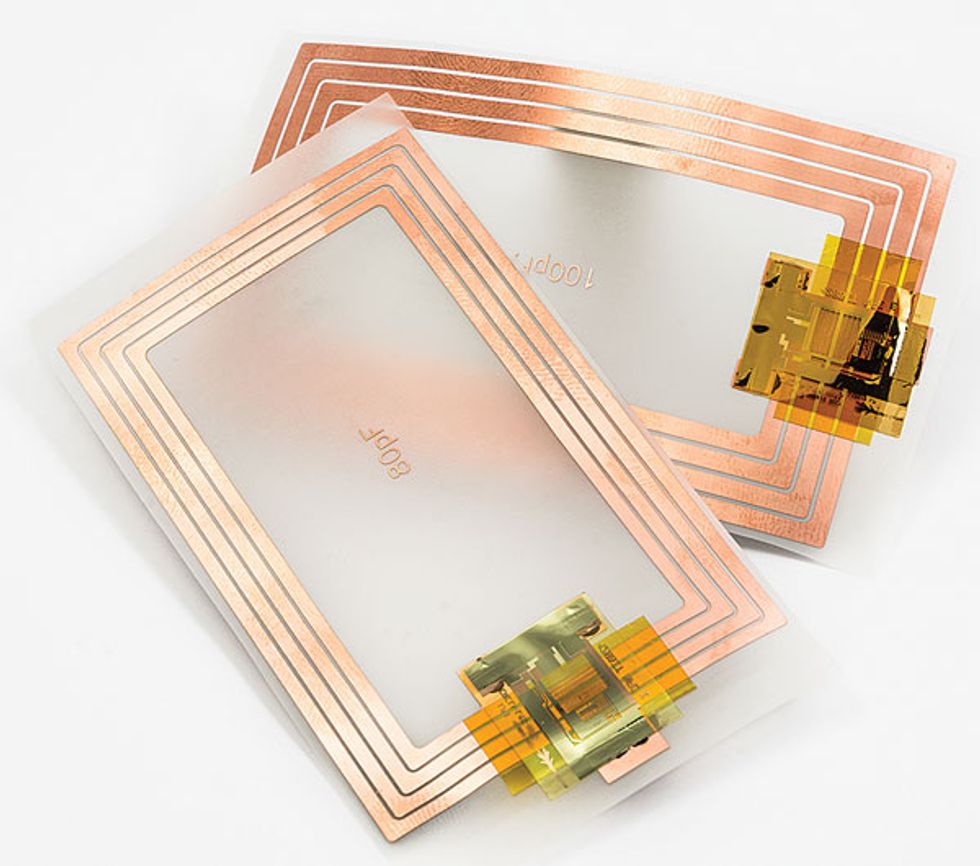
Talk is Cheap: Flexible plastic sensors could interrogate the contents of a package and use near field communications tech, already in today’s smartphones, to transmit their data.
Photo: Imec
MEMS sensor chips typically have dimensions of only 1 or 2 millimeters on a side, which means that tens of thousands can be economically produced on 200-mm-diameter silicon wafers. Today’s price for high-volume MEMS sensors, such as microphones and gyroscopes, is only US $0.10 to $0.50 per sensor. That makes them suited for use in smartphones, fitness trackers, and other consumer electronics products that cost about $100.
For one-off use in food packaging, medical tests, or smart clothing, where the product might cost less than $10, economics will demand that the sensors cost barely a penny. In other words, MEMS sensor prices will need to be at most one-tenth of what they are today for widespread use in such low-cost IoT products.
Although there are yet more costs to be wrung out of silicon MEMS manufacturing, the potential savings is ultimately limited by the cost of the silicon itself. Today, a MEMS sensor measuring 1 mm by 1 mm made on a 200-mm-diameter wafer contains approximately $0.002 worth of semiconductor-grade silicon.
Let’s do some simple math to illustrate the problem. (Skip to the next paragraph if you’d rather not.) To sell a 1-mm2 sensor for a penny ($0.01), the manufacturer’s cost to make it should be no more than $0.007, because most manufacturers would hope to collect at least a 30 percent profit margin, or $0.003 in profit, on the sale of the sensor. By today’s rule of thumb in sensor manufacturing, the MEMS chip costs roughly 30 percent of the finished sensor’s cost, with the remaining 70 percent of the cost coming from the packaging, testing, readout electronics, and calibration of the sensor. So that leaves 30 percent of $0.007 for the cost of the MEMS chip alone, or $0.002. Finally, the silicon material contributes roughly 20 percent of the cost of the unpackaged MEMS chip. That leaves us with a budget of only $0.0004 for the sensor’s silicon.
In other words, to make a MEMS sensor that costs a penny, the silicon would have to cost one-fifth what it costs today. Looking at historic silicon price trends, it seems unlikely that prices could ever fall that much. (In fact, the price of silicon rose more than tenfold over today’s price during the photovoltaic industry rush of 2006–2010.) Shrinking the MEMS chip to hit the 1-cent price target won’t work either. Being dependent on the mechanical properties of silicon, fluids, and gases, most MEMS devices wouldn’t work if you shrink them that drastically. Instead, we’ll have to make sensors from materials that are much cheaper than silicon.
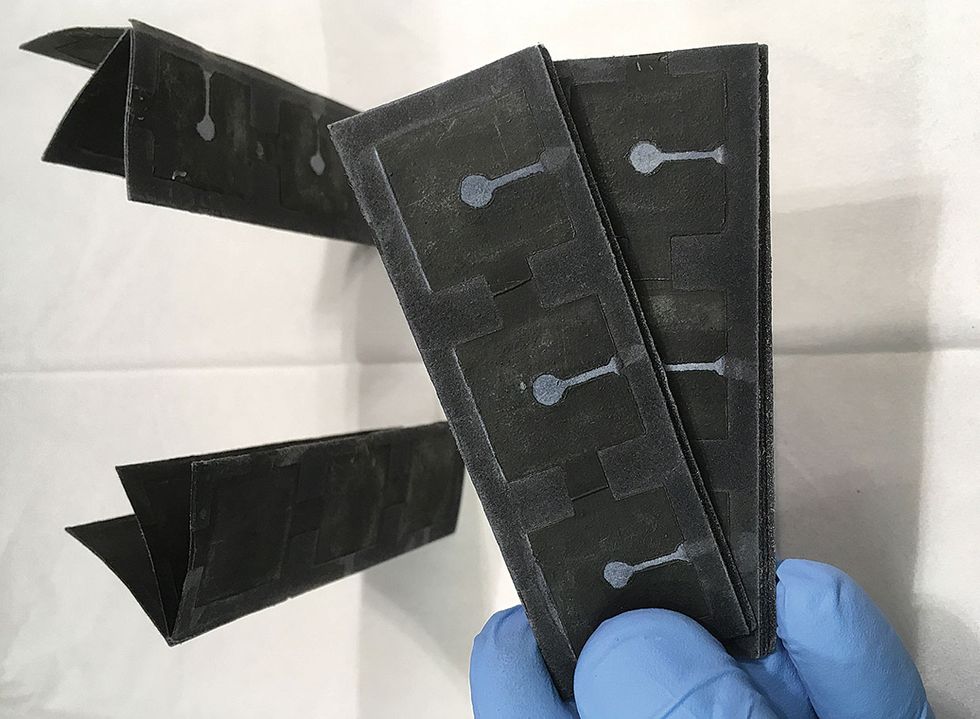
Bacterial Batteries: Seokheun Choi’s group at SUNY Binghamton is making paper-based batteries that use electrons produced by bacterial metabolism.
Photo: Seokheun Choi
Across all industries, market forces have always motivated manufacturers to move to less costly materials. In automobiles, metal parts gave way to plastic; in furniture, leather gave way to vinyl; and in electronics, LEDs migrated from sapphire substrates to silicon.
Now even MEMS sensors are moving—toward plastic and paper. While making electronic devices on these simple substrates may seem like a radical new idea, it is not. The precedent stretches back nearly 40 years, when T. Peter Brody and Derrick P. Page at Westinghouse first fabricated thin-film transistors (TFTs) on a paper substrate. They imagined using roll-to-roll printing methods for products such as electronic paper documents and implantable medical devices.
Researchers have been working on paper and plastic sensors for years, and lowering the cost of sensors hasn’t been their only motivation. Competition for federal funds has led researchers to seek ways to make microtechnology without clean rooms and other exotic tools. Then there’s the rising interest in constructing sensors out of materials more flexible and biodegradable than silicon, for use in invasive medical applications. And as electronics applications embrace the entire world, there’s a growing need in developing countries to make use of the ultimate low-cost material—paper.
Product engineering requires that you not use a golden hammer where an iron hammer will do. In IoT applications where flexibility, low cost, or disposability are required but sensing needs are not so rigorous, plastic and paper sensors will get the job done at an attractive price.
An IoT sensor has two significant components: the sensor itself, which detects a specific physical or chemical event, and a telemetry unit, which transfers the sensor’s data to the Internet. The telemetry unit may not need a battery, instead relying on a passive antenna coil to inductively transfer the data to a nearby radio-frequency identification device (RFID) or a near field communication (NFC) reader. Or the unit may have a battery, a radio, and an antenna, to actively transmit the data at cellphone, Wi-Fi, or Bluetooth frequencies.
An IoT sensor may even have a certain amount of intelligence or data-interpretation capabilities. For that, paper integrated circuits, made from printed lines of metallic and semiconducting inks, are under investigation. In 2011, engineers at the Belgian research firm Imec built an 8-bit microprocessor on flexible plastic using thin-film transistors made of organic semiconductors. They followed it up last year with a printed plastic NFC chip made using IGZO—a metal-oxide semiconductor that is a mixture of indium, gallium, zinc, and oxygen. Although these designs are still quite primitive and slow compared with their silicon cousins and might not advance much further due to the limitations of these materials, they have so far proved themselves good enough to do the job at the right price.
But most IoT sensors, particularly the cheap and disposable ones, will rely on external power and intelligence. Both are widely available. For example, all new smartphones are capable of near field communication, which is primarily used for contactless electronic payment systems, such as Apple Pay. This means your phone is probably already equipped to power and talk to a future sausage-freshness sensor.
You can see the move toward flexibility and biodegradability already. One of the first implantable MEMS pressure sensors to be approved by the U.S. Food and Drug Administration, created by CardioMEMS (now part of St. Jude Medical), was a rigid sensor made of quartz, designed to be implanted adjacent to a stent, in order to monitor the efficacy with which the stent does its job of holding an artery open. The sensor includes an antenna buried within the quartz and a thin membrane of quartz that covers a cavity, thus forming a capacitor. When the blood’s pressure squeezes down on the membrane, it changes the capacitance and therefore the resonant frequency of the sensor’s circuit. The change in frequency can be passively measured by an external reader, which interrogates the sensor with an RF signal of known frequency and then compares it with the altered frequency of the return signal.
The problem with a quartz sensor—and with those made of silicon as well—is that they are relatively rigid and quite brittle. It would be better to use more flexible materials, which can conform to the body’s contours and narrow spaces such as those inside blood vessels. Even better would be biodegradable materials, which could dissolve harmlessly in the body after a sensor has finished its work, avoiding any need for surgical removal.
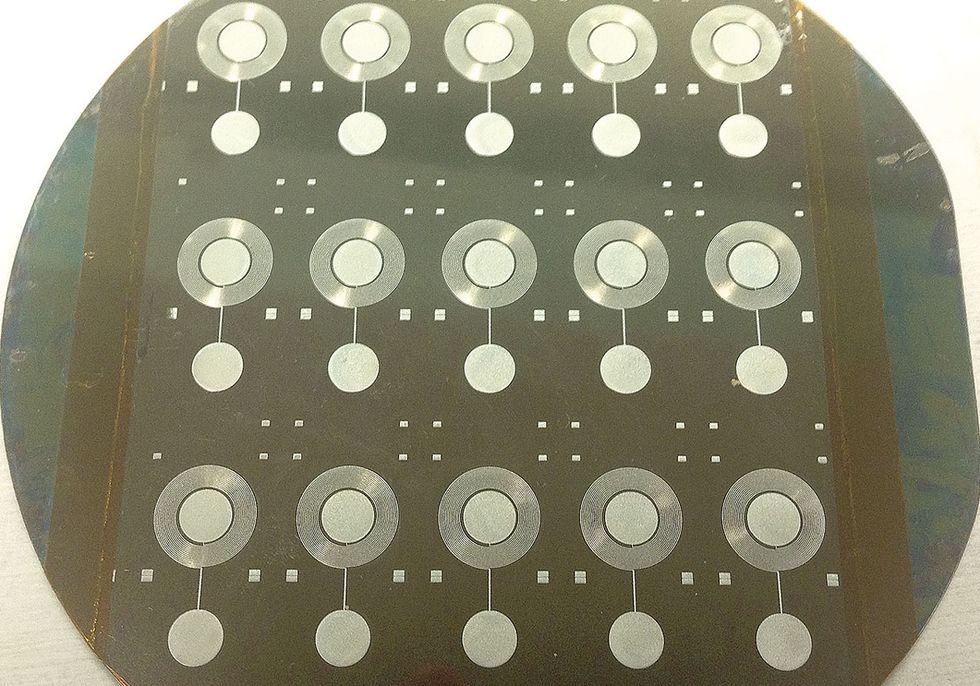
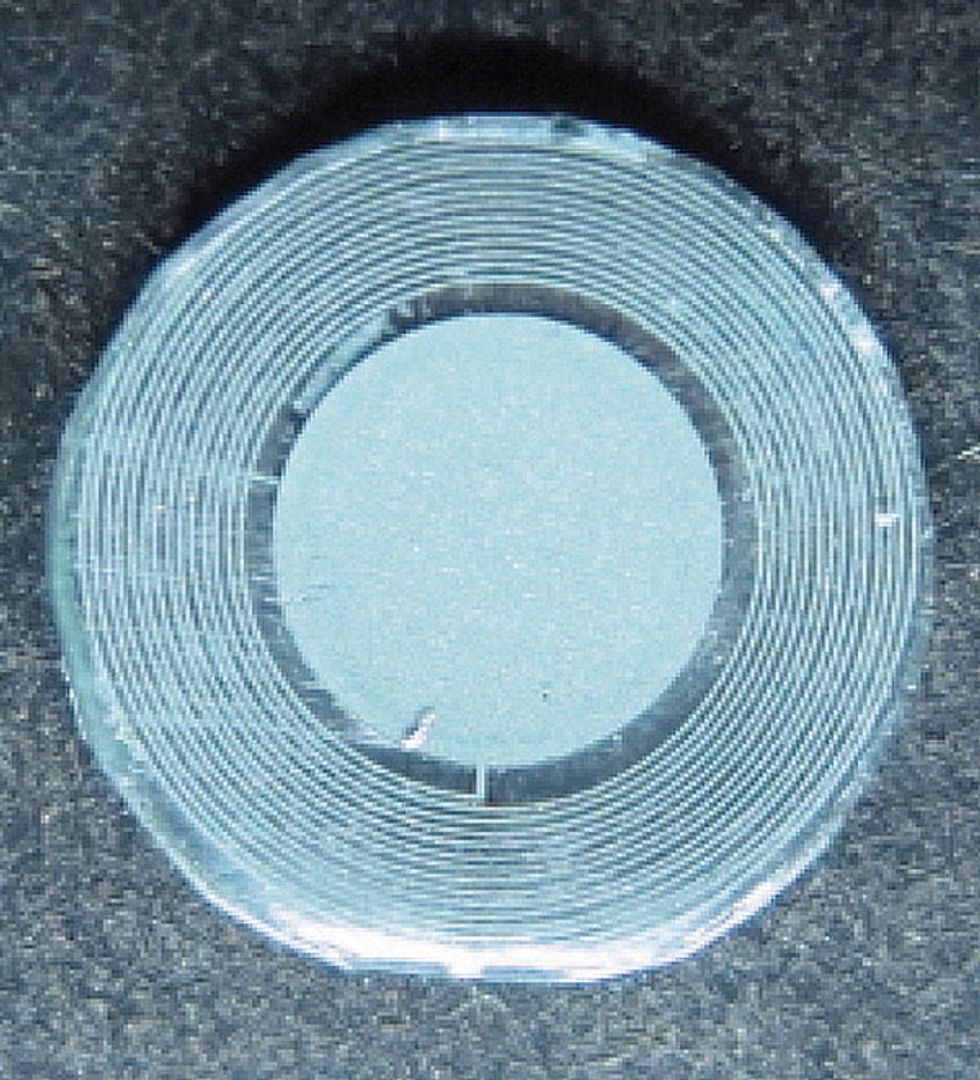
Biodegradable Barometer: MEMS pressure sensors can be made from the same kind of dissolvable material as surgical sutures.
Photos: Mandy Luo/University of Pennsylvania
One of CardioMEMS’s cofounders, the University of Pennsylvania’s Mark Allen, subsequently shifted away from rigid silicon and quartz sensors to making flexible and biodegradable sensors. Graduate students in Allen’s group are now engineering sensors and even batteries from polymers such as poly(lactic co-glycolic) acid (PLGA), polyvinyl alcohol (PVA), and polycaprolactone (PCL), the same materials used in dissolvable surgical sutures. Interconnects and antennas are formed from biodegrading metals such as magnesium or zinc. Using MEMS microfabrication techniques such as photolithography and electroplating, the students have demonstrated biodegradable, millimeter-size pressure sensors with the same wireless data-transmission capability of their quartz ancestors.
Biodegradable sensors are exciting for applications beyond the medical realm. They would be highly attractive for use in any environmentally sensitive activity, such as precision agriculture. Imagine a farmer planting a sensor with every new plant, in order to monitor soil hydration during the growing season. By harvest time, the sensor would be long gone, harmlessly dissolved into the soil. Similarly, biodegradable sensors would be the best choice for any other human-safe disposable item, such as packaging that could monitor food freshness.
A progenitor of the sausage-sniffing sensor has already been demonstrated. Silvana Andreescu’s group at Clarkson University, in Potsdam, N.Y., has made a paper-based sensor that can detect food spoilage. Nanostructures made of inorganic chemicals printed on paper react with the gases released by decomposition; the nanostructures then change color in proportion to the gas concentration. At the moment, the sensor’s result must be read visually. For our imagined smartphone application, adding a means of electronic readout and data transmission would make the sensor IoT ready.
George Whitesides’s group at Harvard University is doing just that by adapting paper-based medical diagnostic sensors that change color and are read visually, like a home pregnancy test strip, to a readout method based on RF. Using techniques such as screen printing and inkjet printing to deposit waxes and conductive inks, Whitesides’s researchers have been able to create paper microfluidic sensors, chemical sensors, humidity sensors, and even force sensors. Their goal is a suite of medical diagnostic sensors that people in developing countries can afford. You can bend, flex, and fold these devices to fit the purpose, and when they’ve fulfilled their duty, you can light them with a match or just let them naturally decompose. As we contemplate billions of IoT sensors and products, their ability to break down and return to nature may prevent landfills from overflowing with devices from an Internet of Used-Up Things.
Though many disposable sensors can get by with external RF energy, some will still need their own power sources. That’s why Allen’s group at Penn is also exploring biodegradable electrochemical batteries made of the same polymers and metals they use to build their sensors. The saline environment inside the human body provides the battery’s electrolyte, conveniently avoiding the toxic acids used in typical batteries.
At the State University of New York at Binghamton, Seokheun Choi’s group is developing a paper-based battery with an unconventional source of electrons: bacteria. Some bacteria—which you can find in any muddy puddle—generate electrons as they metabolize food. These bacteria affix themselves to metal electrodes printed on paper, and those electrodes collect the emitted electrons. You need a stacked series of bacterial battery cells to create microamperes of current, and that’s easily arranged by origami: Just fold the paper upon itself multiple times.
The very flexibility of paper and plastic makes them difficult to manufacture into sensors, which typically require tight dimensional control. Plastics, for example, stretch and deform under the slightest changes in force or temperature. In the semiconductor industry, we have learned to control the size of features down to a few nanometers; the dimension of a plastic part might change tens of micrometers just due to a temperature increase of a few degrees. We’ll need new and different sets of design tools and manufacturing equipment to get to mass production of plastic and paper-based sensors.
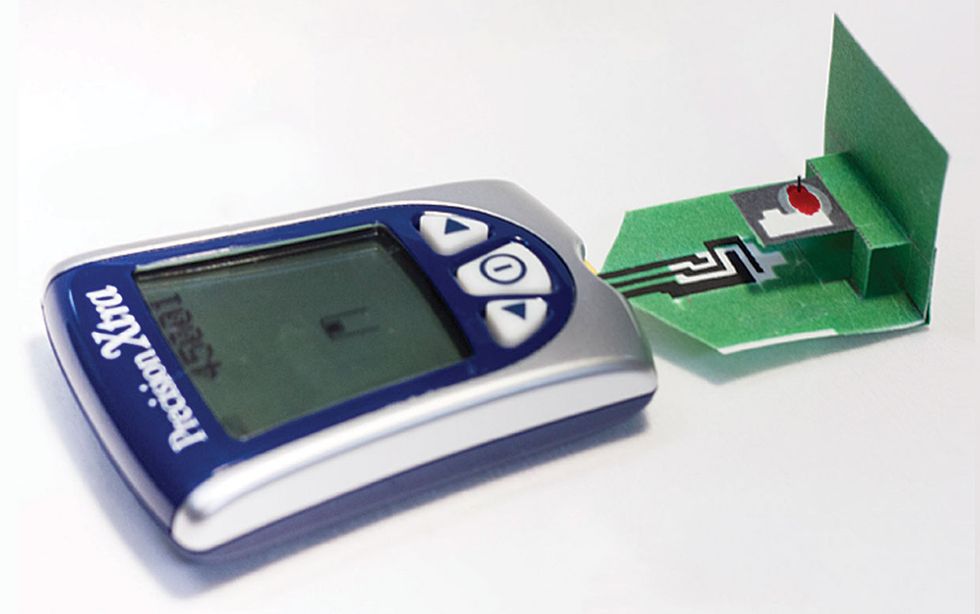
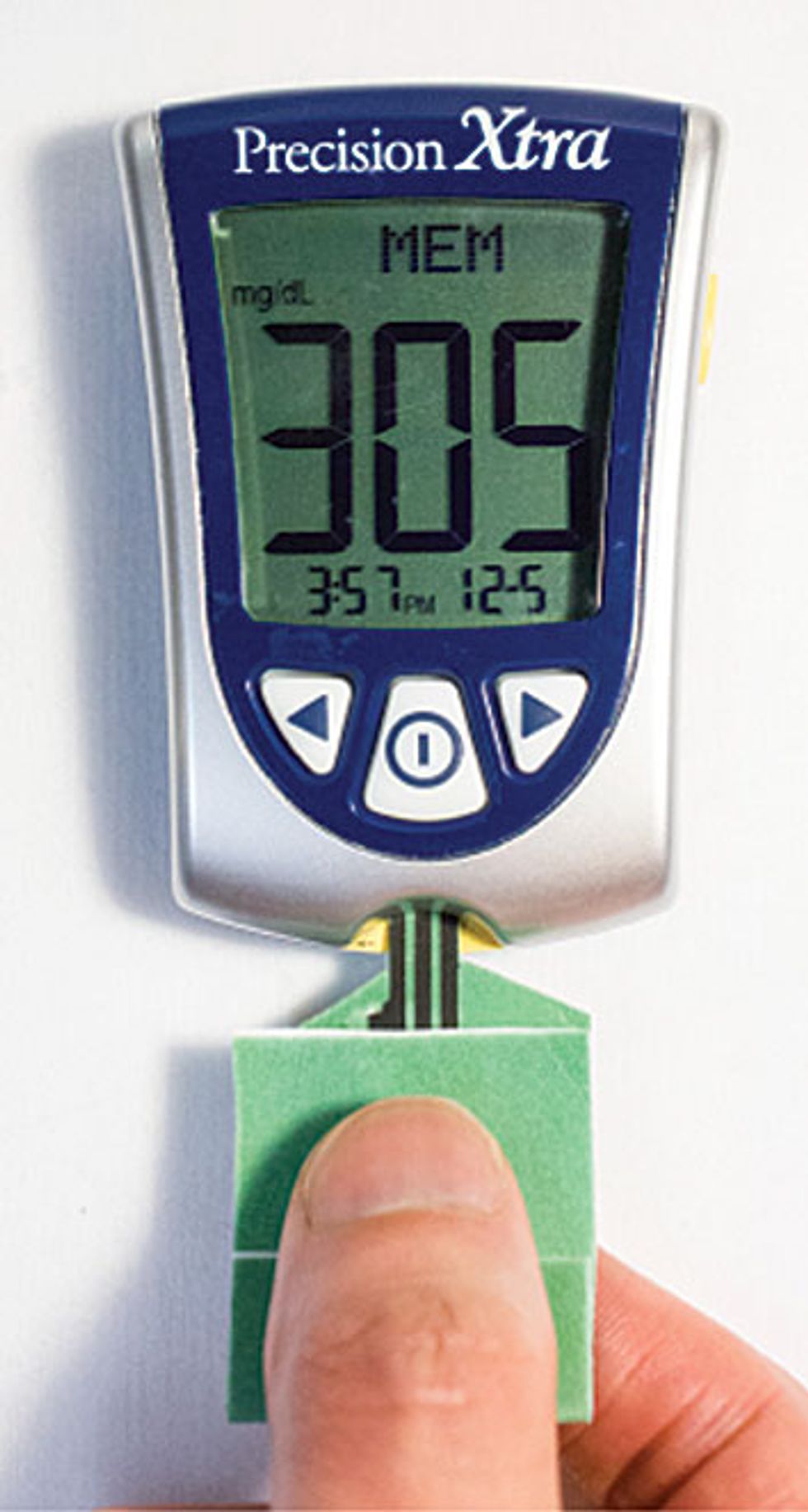
Bloody Cheap: A paper electrochemical sensor measures glucose in a blood sample and communicates with a reading device.
Photos: Whitesides Lab/Harvard University
Technologies for processing paper and plastic, however, have been well-established for decades, even centuries, in other applications: the paper printing press and paper-handling machinery, for making newspapers and books; screen printing and inkjet nozzles for precision printing; roll-to-roll plastics manufacturing, for making tapes and webbings; meter-size large-format lithography and thin-film deposition, for manufacturing meter-wide LCD television panels.
By modifying these technologies for the specific needs of plastic and paper electronics fabrication, a new industry could soon be born. The U.S. Department of Defense has already begun pushing for this new manufacturing infrastructure. In September 2016, the NextFlex center opened in San Jose, Calif. The Defense Department organized the initiative and pledged $75 million in funding to promote research and development in advanced manufacturing methods there for flexible hybrid electronics. The center’s goal is to rid electronics of its sturdy skeleton, the planar printed circuit board, upon which the design and manufacturing of electronic systems has been dependent for the last 60 years.
Flexible hybrid electronics provides a stepping-stone toward the vision of paper and plastic electronics. It provides a practical compromise: We haven’t yet mastered making high-performing transistors and other elements on these substrates, but we can graft traditional silicon components thinned to less than 50 μm (and therefore made flexible) onto plastic, fabric, and paper. In the near term, the Defense Department expects that this manufacturing technique will lead to the lightweight and wearable electronics it seeks for its soldiers and military equipment.
In the longer term, the development of new capabilities for manufacturing plastic and paper sensors, and the accompanying business models, will open up a whole universe of new product possibilities. Compare it to the “fabless” model of making chips; when it took hold during the late 1980s, an explosion of design innovation soon followed. Young chip companies, no longer burdened by the huge capital expense of owning a fab, could focus on innovative designs while letting foundries do their fabrication work. The fabless manufacturing model could be credited with accelerating the development of countless consumer electronics products, such as smartphones, tablets, and gaming consoles.
Plastic and paper electronics manufacturing could potentially let industry leap beyond the fabless model. When manufacturing uses simple materials and methods, it doesn’t need to occur in a facility nearly as complex as a fab; there could be a factory in every town or even in every household. It’s a distributed manufacturing model. Already today, you can find 3D polymer printers in both the home workshops of hobbyists and in professional machine shops. It’s not a big leap to imagine that within 20 years, advanced 3D printers could also fabricate flexible sensors and electronics in the home.
Of course, not all sensor technology could move to plastic or to paper. Many high-performing sensors like microphones and gyroscopes must remain on silicon because their physical performance depends on properties of silicon or on the submicrometer tolerances achieved only with traditional silicon micromachining. However, the simpler devices needed for high-volume consumer IoT, such as sensors for temperature, light, gas, or pressure, will migrate from silicon to plastic or even paper. High-volume, single-use IoT applications for consumers will only need sensors with “good enough” performance and a low enough price.
We’re heading toward a bifurcation in electronics manufacturing, between traditional silicon methods and the emerging low-cost, flexible substrate methods. New research developments, rising demand for flexible and low-cost sensors, and growing awareness of the need to reduce the environmental impact of electronics manufacturing is creating critical momentum to finally bring plastic and paper sensor technologies into the mainstream.
This article appears in the December 2018 print issue as “The Internet of Disposable Things.”
About the Author
Alissa M. Fitzgerald is the founder and managing member of the MEMS design firm A. M. Fitzgerald & Associates, in Burlingame, Calif.


